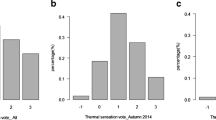Abstract
Groups of secondary schoolchildren in England were asked to assess thermal conditions in winter according to subjective sensations of warmth. Individual comfort votes were averaged for each group and regressed, firstly on estimates of microclimatic warmth, and secondly, in combination with external meteorological parameters. It appeared that thermal comfort was related not only to indoor temperatures, but also to outdoor warmth. The most similar regressions between the sexes, however, contained variables also representing humidity and changes in the external warmth — humidity environment. In particular cool-humid days and changes to warmer-drier weather were related to a decreased need for indoor warmth.
Zusammenfassung
Gruppen von Mittelschülern in England wurden aufgefordert, im Winter die Wärmebedingungen nach dem subjektiven Wärmeempfinden abzuschätzen. Die individuellen Behaglichkeitsangaben wurden für jede Gruppe gemittelt und mit der Wärme im Raum und äusseren meteorologischen Parametern korreliert. Das Wärmeempfinden stand nicht nur in enger Beziehung zu den Raumtemperaturen sondern auch zu der Aussenwärme. Selbst die ähnlichsten Regressionen für beide Geschlechter wiesen jedoch Abweichungen auf in Abhängigkeit von der Feuchtigkeit und Wechseln im äusseren Temperatur-Feuchte-Milieu. Besonders an kühl-feuchten Tagen und beim Wechsel nach wärmeren trockenerem Wetter bestand ein vermindertes Bedürfnis für Wärme im Raum.
Resume
Des groupes d'élèves du degré moyen d'Angleterre ont été priés d'estimer, en hiver, les conditions de chaud d'après des critères subjectifs. On a établi pour chaque groupe les moyennes des indications individuelles de confort et calculé ensuite les corrélations avec la température des locaux et les paramètres météorologiques relevés à l'extérieur. La sensation de chaud ne fut pas seulement en étroite relation avec la température des pièces d'habitation, mais aussi avec la température extérieure. Des régressions analogues, calculees séparément pour les deux sexes, ont montré des différences dépendant de l'humidité ou des variations de température et d'humidité du milieu extérieur. On a constaté une diminution des besoins en chaleur dans les locaux durant les jours frais et humides et lors de changements vers un temps plus chaud et plus sec.
Similar content being viewed by others
References
ASHVE TECHNICAL ADVISORY COMMITTEE OF PHYSIOLOGICAL REACTIONS (1942): Physiological influence of atmospheric humidity. J.Inst.Heat.Vent.Eng., 9: 369–376.
AULICIEMS, A. (1969): Thermal requirements of secondary schoolchildren in winter. J.Hyg. (Lond.), 67: 59–65.
BEDFORD, T. (1936): The warmth factor in comfort at work. Rep. ind.Hlth.Res. Bd, No. 76.
BENZINGER, T.H., KITZINGER, C. and PRATT, A.W. (1963): The human thermostat. In: Temperature, its Measurement and Control in Science and Industry. Vol. 3. Herzfeld, C.M. (ed.), Reinhold, New York, 637–665.
BLACK, F.W. (1954): Desirable temperatures in offices. A recent study of occupant reaction to the heating provided. J. Inst. Heat.Vent.Eng., 22: 319–328.
BURTON, A.C. and EDHOLM, O.G. (1955): Man in a Cold Environment. Edward Arnold, London.
ELLIS, F.P. (1952): Thermal comfort in warm humid atmospheres. Observations in a warship in the Tropics. J.Hyg.(Lond.), 50: 415–432.
GLICKMAN, N., INOUYE, T., KEETON, R.W. and FAHNSTOCK, M.K. (1948): Comparison of physiological adjustments of human beings during summer and winter. Heat.Pip. Air Condit., 20: 113–119.
HICKISH, D.E. (1955): Thermal sensations of workers in light industry in summer. A field study in Southern England.J. Hyg.(Lond.), 53: 112–123.
KOCH, W., JENNINGS, B.H. and HUMPHREYS, C.M. (1960): Environmental study. II. Sensation response to temperature and humidity under still air conditions in the comfort range. Trans.Amer.Soc.Heat.Refrig. Air-Condit. Eng., 66: 264–287.
MISSENARD, A. (1937): Warmth and comfort. J.Inst.Heat.Vent.Eng., 4: 602–606.
TROMP, S.W. (1963): Medical Biometeorology. Elsevier Publ.Comp.,Amsterdam-London.
Author information
Authors and Affiliations
Rights and permissions
About this article
Cite this article
Auliciems, A. Effects of weather on indoor thermal comfort. Int J Biometeorol 13, 147–162 (1969). https://doi.org/10.1007/BF01552736
Received:
Issue Date:
DOI: https://doi.org/10.1007/BF01552736




